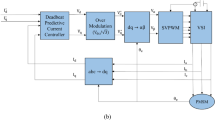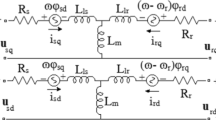Abstract
A force ripple model considering both non-ideal magnetic field and windings was developed to study methods for the suppression of the force ripple in an ironless permanent-magnet linear synchronous motor (PMLSM) to improve its low speed stability and position tracking performance. With this new model, which uses the d-q reference frame, the force ripple information could be calculated at discrete positions using the winding features and magnetic flux density (MFD). A PMLSM with two movers and one stator was designed to measure the air gap MFD and force ripple at different positions. The reliability of the model was validated through a comparison of the force ripple data obtained with the new model and practical measurements. The error ratio between the theoretical calculations and measured forces was less than ± 4%. Force constants were available from the model using the measured MFD, and these force constants were then used as force compensation coefficients to adjust the current in terms of the mover’s position. The force ripple, particularly the periodic force ripple causing resonance of the mechanical system, was significantly reduced with compensation. The theoretical analysis and experimental results show the effectiveness of the improved model.











Similar content being viewed by others
References
Gieras, J. F., Piech, Z. J., & Tomczuk, B. (2011). Linear synchronous motors: Transportation and automation systems (2nd ed.). Milton Park: Taylor & Francis.
Xu, L., & Yao, B. (2001). Adaptive robust precision motion control of linear motors with negligible electrical dynamics: Theory and experiments. IEEE/ASME Transactions on Mechatronics, 6(4), 444–452.
Abdalla, I. I., Ibrahim, T., & Nor, N. B. M. (2017). The fabrication and characterization of short-stroke tubular linear permanent-magnet motor. In 9th international conference on robotic, vision, signal processing and power applications. Springer, Singapore.
Parker Linear Motor Manual, Parker Hannifin Corp., Rohnert Park, CA2010.
Jahns, T. M., & Soong, W. L. (1996). Pulsating torque minimization techniques for permanent magnet AC motor drives—A review. IEEE Transactions on Industrial Electronics, 43(2), 321–330.
Lim, K.-C., Woo, J.-K., Kang, G.-H., Hong, J.-P., & Kim, G.-T. (2002). Detent force minimization techniques in permanent magnet linear synchronous motors. IEEE Transactions on Magnetics, 38(2), 1157–1160.
Chung, S.-U., Kim, J.-W., Woo, B.-C., Hong, D.-K., Lee, J.-Y., & Koo, D.-H. (2011). Force ripple and magnetic unbalance reduction design for doubly salient permanent magnet linear synchronous motor. IEEE Transactions on Magnetics, 47(10), 4207–4210.
Rohrig, C., & Jochheim, A. (Eds). (2001). Identification and compensation of force ripple in linear permanent magnet motors. In Proceedings of the 2001 American control conference (Vols. 1–6, pp. 2161–2166). IEEE.
Mattavelli, P., Tubiana, L., & Zigliotto, M. (2005). Torque-ripple reduction in PM synchronous motor drives using repetitive current control. IEEE Transactions on Power Electronics, 20(6), 1423–1431.
Xu, L., & Yao, B. (2001). Output feedback adaptive robust precision motion control of linear motors. Automatica, 37(7), 1029–1039.
Lu, L., Chen, Z., Yao, B., & Wang, Q. (2008). Desired compensation adaptive robust control of a linear-motor-driven precision industrial gantry with improved cogging force compensation. IEEE/ASME Transactions on Mechatronics, 13(6), 617–624.
Chen, S.-L., Tan, K. K., Huang, S., & Teo, C. S. (2010). Modeling and compensation of ripples and friction in permanent-magnet linear motor using a hysteretic relay. IEEE/ASME Transactions on Mechatronics, 15(4), 586–594.
Jia, Z., Degobert, P., & Hautier, J. (Eds.) (2005). Minimum torque ripple control of permanent magnet synchronous motor in the stationary reference frame. In Proceedings of the 2005 IEEE international electric machines and drives conference (pp. 667–673). IEEE.
Zeng, J., Remy, G., Degobert, P., & Barre, P.-J. (Eds.). (2004). Thrust control of the permanent magnet linear synchronous motor with multi-frequency resonant controllers. In 18th international conference on magnetically levitated systems and linear drives, Shanghai, China (Vol. 2, pp. 886–896). IEEE.
Platen, M., & Henneberger, G. (2001). Examination of leakage and end effects in a linear synchronous motor for vertical transportation by means of finite element computation. IEEE Transactions on Magnetics, 37(5), 3640–3643.
Park, R. H. (1929). Two-reaction theory of synchronous machines generalized method of analysis-part I. Transactions of the American Institute of Electrical Engineers, 48(3), 716–730.
Park, R. H. (1933). Two-reaction theory of synchronous machines-II. Transactions of the American Institute of Electrical Engineers, 52(2), 352–354.
De La Ree, J., & Boules, N. (1989). Torque production in permanent-magnet synchronous motors[J]. IEEE Transactions on Industry Applications, 25(1), 107–112.
Acknowledgements
The authors acknowledge the contributions of Anhui Hopemotion CO., Ltd. for providing a linear motor and an economical Rapid Control Prototyping (eRCP and cSPACE) system. Xianmin Chen is also grateful for the support of the China Scholarship Council (CSC).
Funding
Funding was provided by National Natural Science Foundation of China (Grant No. 51505116), Natural Science Foundation of Anhui Province (Grant No. 15080855MZ221), China Postdoctoral Science Foundation (Grant No. 2016M590563).
Author information
Authors and Affiliations
Corresponding author
Additional information
Publisher's Note
Springer Nature remains neutral with regard to jurisdictional claims in published maps and institutional affiliations.
Rights and permissions
About this article
Cite this article
Zhen, S., Chen, P., Chen, X. et al. Force Ripple Modeling and Minimizing of an Ironless Permanent-Magnet Linear Synchronous Motor. Int. J. Precis. Eng. Manuf. 20, 927–935 (2019). https://doi.org/10.1007/s12541-019-00065-5
Received:
Revised:
Accepted:
Published:
Issue Date:
DOI: https://doi.org/10.1007/s12541-019-00065-5




